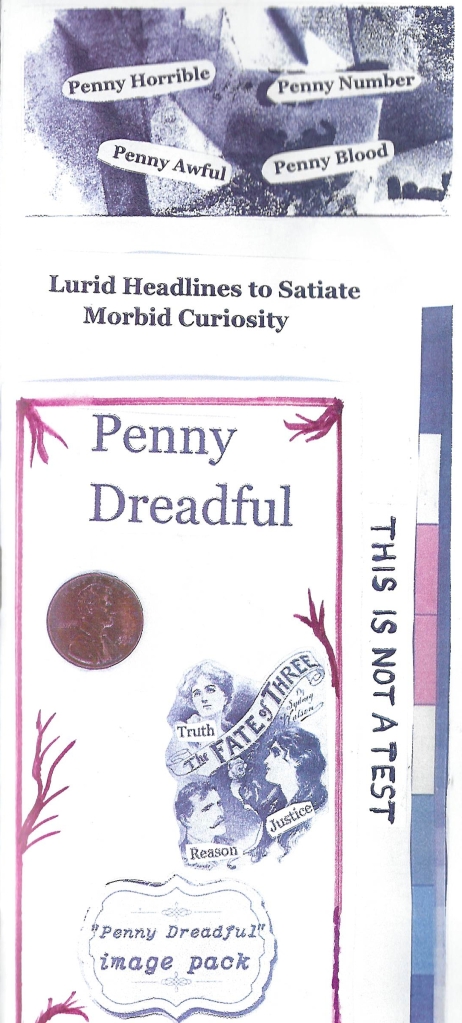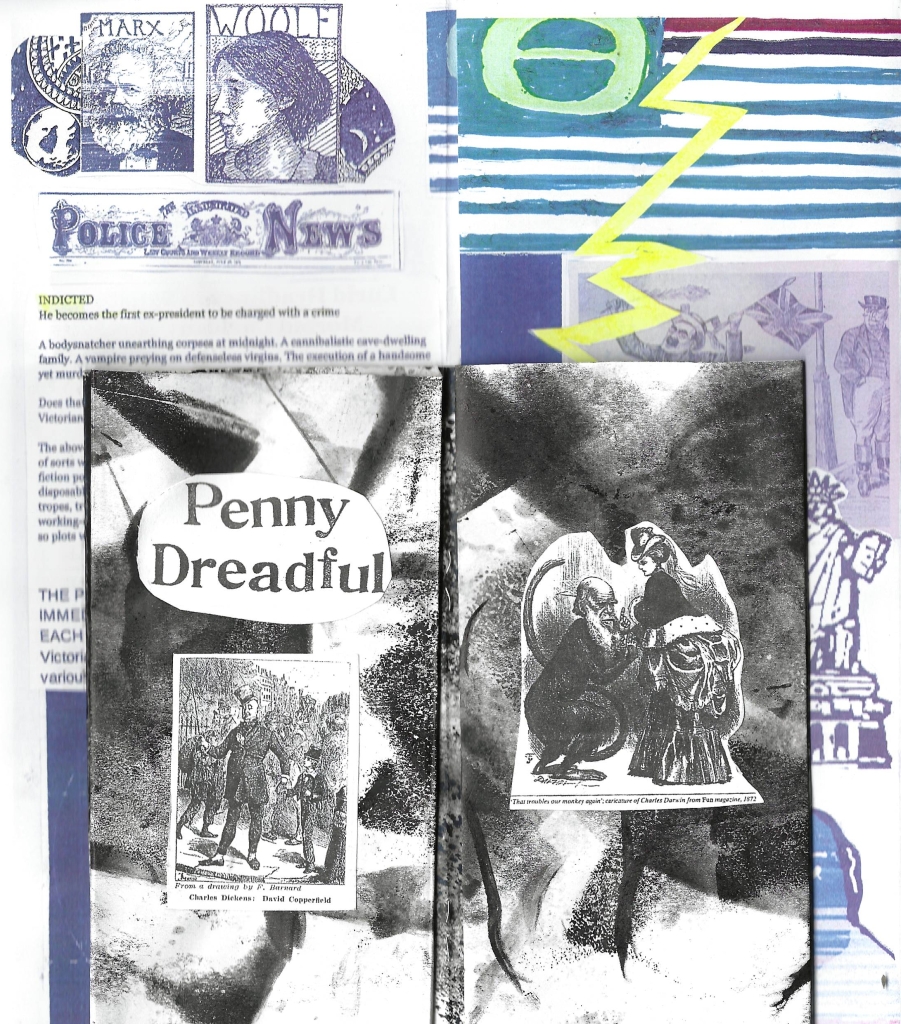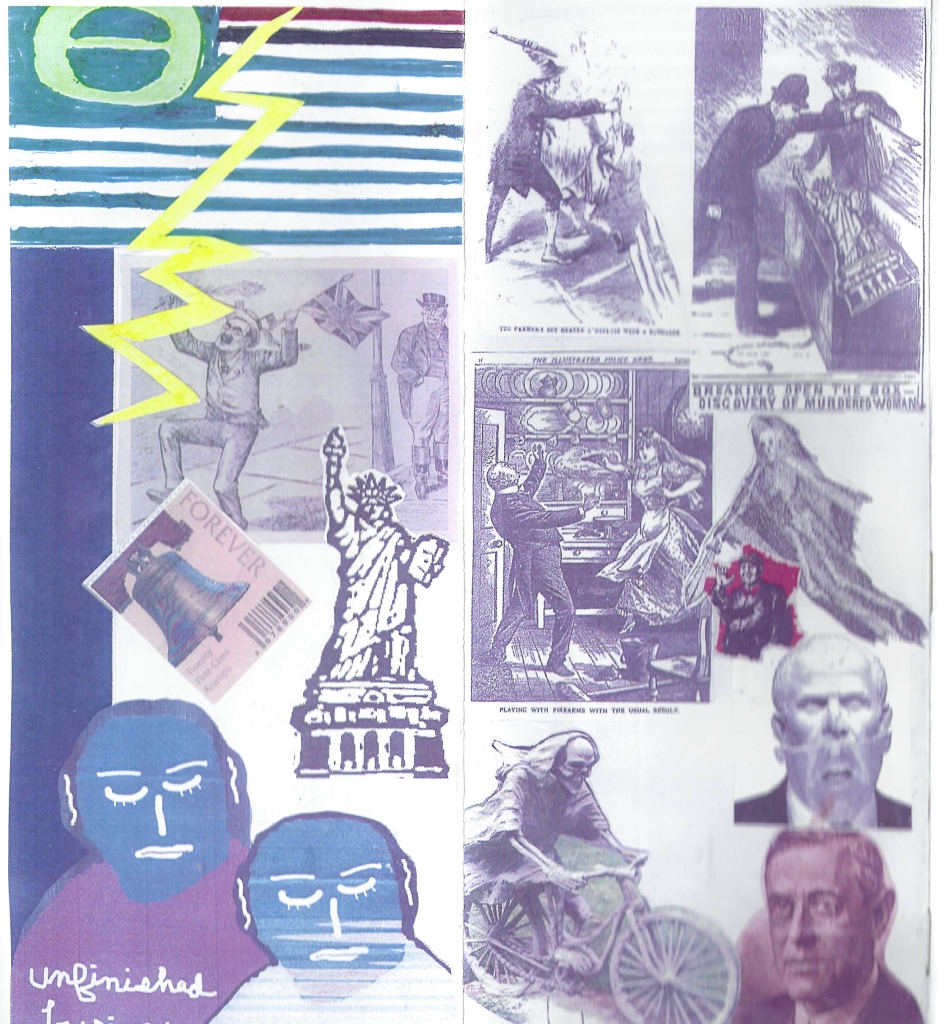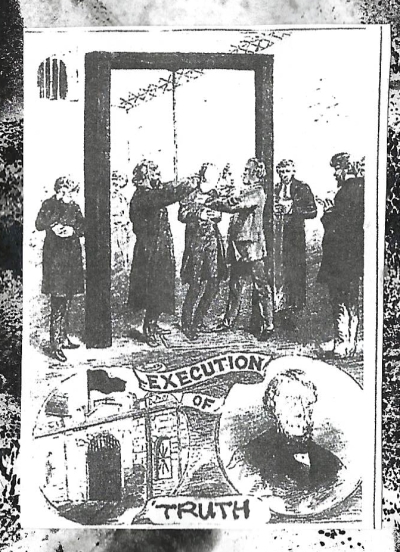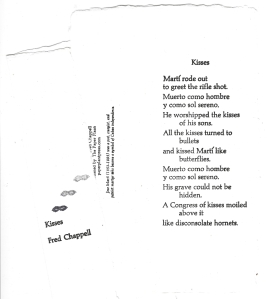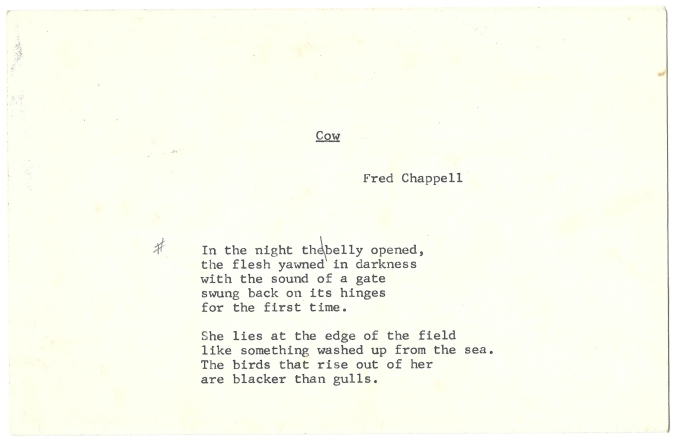PENNY DREADFUL an essay in small print
My latest and biggest ever mail art is out in the world in an edition of 120! Based on an early form of street literature I learned about from Dr. Charles Edge at UNC-CH in the early 70’s. I previously used the format in a self-publishing project with 6th graders at Glenwood Elementary my final year in Chapel Hill. Sent one year from an inauguration that will be a watershed for our country – one way or the other.
The format is a 2-sided color photocopy enclosing a small booklet made of an 11×17 sheet strategically used to clean off excess ink from the platen after letterpress printing nature book covers. I also used these for the zine version of my pandemic mail art piece, Plague Daze.
Historic images of Penny Dreadful covers and other historical print images (occasionally modified) were cut out and glued into the booklet. Over 3000 pieces! Not all are shown.
Throughout, the reproduced pencil drawings are my tracings and re-drawings of print images. Hilariously, the mounted penny is the specific reason this mailing is slightly too thick to qualify as first class by current (much stricter) regulations. Also, mounting the penny with glue on the back side is surely a defacement, which is a federal offense. I love the subversion but I fervently hope none get returned (109 are in the mails as I write).
A big thanks to contributors of images: David Larson, John Justice, Jonathan Laurer and of course the online resources for Penny Dreadfuls. This mailing was sent in the memory of Ray Johnson, correspondance artist extraordinaire. Richard C, Ray J’s curator, and John Justice received draft versions of the project which were essential in finalizing the final design. Mail art lives!
Our country and its democracy, such as it is, WILL survive – American history is filled with far worse episodes. Besides, the really big boys are not going to let our lucrative systems break down – and The System is inexorably getting more progressive and global all the time – but this has been a hell of a wake-up call for all of us. God bless us all.
Feedback on Penny Dreadful
Mary R: Shadow and light conjoined in a delightful dreadful death of democracy, a fine memento mori for Ray….. most grateful and amazed!
Alyssa S: It was such s surprise and delight to receive! I’m looking forward to spending more time with it. Each look, I catch something I didn’t see before.
Cheryl C T: There’s so much to see. Each time I look, I find another interesting detail.
Lee M C: I am really moved by this work..opening it and being..yes this is today and yesterday and the impending proverbial bad penny! amazing imagery , prophetic synchronicity
Eric N:Got my Penny Dreadful mail art a few days ago. Thank you so much–a remarkable assemblage. I love it
Marcia C: What a wonderful surprise to have your very cool little book arrive in the mail. Thank you so much! Penny Dreadful is a rouge book that has some wonderful fingerprints on it. I can see all your hand work and paste and stick and fold.
Jen C.: You have lit up my imagination once again, John.
Fred Chappell, Consummate Poet and Beloved Teacher
When I left Chapel Hill for Greensboro I was determined not to be a professor/writer-wannabee and was highly suspicious and dubious of university writing programs. But UNC-G is a small campus and I was soon active and prominent as a new papermaker and nebulous Creative, though the term did not exist in 1976. I became acquainted with the renowned Fred Chappell, and though I did not become his writing student, he read what I gave him and was kind and very helpful in chats and, later, letters. What a generous soul who celebrated life in some of the richest detail to be found in verse. He wrote the story of his life in rural Canton in poems that were like the richest bits of a short story. His actual fiction was wonderful but never became as well known. The first of his science fiction pieces was Dagon, and having read in an interview that he considered it readable in one sitting, and wrote it with that approach, I immediately did so and told him. He seemed tickled, but then Fred was always bubbling with some kind of energy. He was a learned man and intuitive teacher; he could sound out a human condition and reach out to it with an effortless good humor.
Fred drank in the late afternoons, usually with his graduate students, at the bar on Walker Street and I sometimes bicycled there and sat near them. I was starting a new life after leaving my high school sweetheart wife and starting to write The Suicide of Hooker Van Dusen, which was dedicated to Fred and to the memory of Randall Jarrell, who preceded Fred as a great writer at UNC-Greensboro and whose wonderful poetry was sometimes tinged by a smallness of moral fortitude in living out his L.A. style life in a small town while looking out from his lectern at future schoolteachers, mostly female who, in one infamous poem, reminded him of doe-eyed cows. In huge contrast, Fred Chappell was a southern saint who embraced the beauty and power of rural life and fused his vision of it with a sophisticated and supremely expressive sensibility. He also took his teaching very seriously and gave of himself like few of his talent do. He did like a drink, and that became a hallmark of his legend. My favorite Fred Chappell memory is auditing a film class he co-taught with another UNC-G prof. It was not Fred’s turn to teach, and he was sitting in the back of the tiered lecture hall, having arrived a bit late from Walker Street. The film was Blue Angel, and the professor asked, “Why did the director pick Marlene Dietrich?.” From the upper back, Fred stands and bellows “BECAUSE SHE WAS THE MOST BEAUTIFUL WOMAN IN THE WORLD!!” Fred stopped drinking a few years after I first met him and entered his retirement years as a legendary and transformative figure in North Carolina literature. My novelette became my first published book, and its writing was permeated with the ghost of a writer gone and the warm encouragement of the one who was there. Fred wrote me a nice note about the manuscript of it, and later gave me a couple of excellent PR blurbs in comments about future projects.
I worked hard to stay in touch with Fred, and when I started publishing, he was first on my list of possibilities, and after seeing samples of my hand-laid paper broadsides, he sent me two poems. The first exists in reprinted form and is still in print. The original publication in 1983 had a second poem on the back. I am sharing Fred’s manuscript copy of that one. I am so proud of having published these, and so grateful Fred had such a long run of life and literature. He passed on January 4, 2024.
Highly Personal Rauschenberg Exhibit Brings Back Memories
all images shown in deference to Robert Rauschenberg’s estate
The Black Mountain College Museum + Art Center is hosting a traveling exhibit of a special set of work by Robert Rauschenberg – gifts, many made just for her, to his studio manager and confidant of 30 years, Bradley Jeffries. It’s an outstanding show with an initial grouping that is one of the most sensually beautiful I have ever seen in this or any museum. A good range of different media from this most versatile artist is shown, but a predominant one is solvent transfer, which captures pre-existing images, from text to photos to anything, in a dreamy and bluish hued tone of nostalgia.
Much nostalgia for me in seeing a certificate of participation in a glass case, earned by Ms. Jeffries, for completion of the workshop The Power of Art, a program sponsored by Robert Rauschenberg at the Lab School, a self-contained day school in Georgetown in Washington, D.C. which serves students with learning differences. Her’s was for 1999; I was a charter participant the first year in 1994. I was a new art teacher at The Achievement School (now The Fletcher Academy) and applied for the workshop using student linoleum prints executed on scrap linoleum from the school’s gymnasium.
Mr Rauschenberg spent the day with us,as I describe on my Black Mountain College page.
Robert Rauschenberg found out as an adult that he had a learning disability ( as distinguished from being what he thought was “stupid”) from Sally Smith, founder of The Lab School. He became a supporter of the school, and the “Power of Art” program, of which I was a charter participant, rewarded art teachers who worked with that that population. Mr Rauschenberg treated us to a presentation along with his assistant, gave us signed posters, a five hundred dollar gift certificate to Jerry’s Artarama,and sat and listened to each of us present about our work. That evening, we were feted at a private reception at the National Gallery’s East Wing, and Mr Rauschenberg favored us with a tour of his own work on the walls. He discussed his decision to create the “white painting” while at Black Mountain (Josef Albers thought it a needless extreme), and he gave a vivid description of painting the huge 25 foot work which was on display in the main room -smearing his hands with the white lead paint for hours and then having to go into immediate treatment for weeks because of the lead poisoning. He was charming and down-to-earth, yet fragile and a bit ethereal in his personal presence. That was a wonderful day.
Below is a photcopy of my certificate. Sadly (and thoughtlessly) I displayed the original near a south-facing window and it has faded considerably. Just as bad, I used dorm room sticky to mount the poster Mr. Rauschenberg SIGNED. Such is life when you are a generalist with too many pies cooking. But now I have added this event to the several that have linked me repeatedly to Black Mountain College over the years, leading me now to be a private scholar in the field and an active participant in the activities of the wonderful BMC museum in downtown Asheville.
The Adventurists, by Richard Butner
The Adventurists. Richard Butner. Small Beer Press. 2022.
Richard Butner’s new collection of SF stories is a wonderful look at his long-established but back-burner career as a writer of speculative fiction. Richard is beloved by many in Raleighwood for his quirky and often endearing local theatre roles, his championing of local music and its venues, and (among the cognoscenti) his loyalty to Modernist architecture. This review is overtly from the perspective of a Raleigh native who enjoys the many local references in these stories and the bits and pieces of RB rendered in the protagonists.
The past, though gone forever, can seem so real. Recognition and familiarity run like reinforcing wire through these stories. The past seems hazy but here the cliched futurism of science fiction is reversed and the past makes the content so real through the tangible details of memory. The past is all the content any of us have, when you think about it. Most of the stories end in an unrealized present that is left in your, the reader’s hands, to make of it what you will- armed, perhaps, with the newly discovered possibilities that have just emerged from the story’s view of the past.
Nostalgia for old Raleigh was ignited for me with “At the Fair,” a send-up of the State Fair hoochie-cooch show, which enthralled me as a young teen and lasted amazingly far into the 20th century. But only Richard Butner could make this setting into an anarchic scheme for a socialist utopia. More social commentary is embedded in the most well-known story in the book, “Horses Blow Up Dog City.” Also full of Raleigh bits, from scents of RB’s band, “Angels of Epistemology” to the founder of Humble Pie, it chronicles a viral media star being eaten alive by his life. Perhaps the strongest dose of Raleighwood is found in “Under Green,” featuring a temporarily homeless young woman who takes up residence in the Rose Garden and haunts Raleigh’s magnificent greenways. In a book full of slightly underemployed, sexually cautious male nerds, this is the strongest female character, whose efforts to be a good Samaritan fail but who nevertheless finds a not unhappy ending.
The SF aspects of these stories often involve virtual reality, sometimes close to the most recent developments in the real life versions of the technology. One of the most gripping stories for me, “Give Up,” mirrored my memory of student parents who broke up over the man’s attempt at climbing Everest. In Richard’s story, extreme abuse of the technology is complicated by a criss-cross of realities which sets in with a vengeance. In the final story, “Sunnyside,” the VR is so believable you could imagine donning the all-enclosing suit and joining the wake celebration that brings its subject back to life in the midst of impossibly detailed relics from the past. And if the past is all in our heads, but can become as real as it does in these stories, maybe we really can apprehend the past – or make it more to our liking. These stories make you wonder.
Beautiful Truth 2020/2021
From January 1st through the 20th, I posted quotes about truth on Facebook. These became a mail art zine, whose text and images are below.
Prelude for 2020
Laying Down the King
Motives suspect from the start
Each move examined as a curse
Lashing out at poor prospects
Desperate to protect your own
Geometry? Real estate? Who knows?
Fairness in an infinity of moves
Beauty in pure form- abstract death.
The consideration of consequences
Entails a morbid view.
The convulsive strike can gird
Dystopian dreams anew.
Quotes
Truth is the property of being in accord with fact or reality
Wikipedia
…to agree with the facts, or to state what is the case. Truth is the aim of belief; falsity is a fault. People need the truth about the world in order to thrive. Truth is important.
Encyclopedia Brittanica
1.archaic: fidelity, constancy 2.the body of real things, events and facts: actuality.
Merriam-Webster
And ye shall know the truth and the truth shall make you free.
Jesus
Trouthe is the hyeste thing that man may kepe.
Chaucer, “The Franklin’s Tale”
Rather than love, than money, than fame, give me truth.
Henry David Thoreau, Walden
In his Metaphysics, Aristotle stated: “To say of what is that it is not, or of what is not that it is, is false, while to say of what is that it is, and of what is not that it is not, is true”.
To deny the existence of efficient causes which are observed in sensible things is sophistry…Denial of cause implies the denial of knowledge and denial of knowledge implies that nothing in the world can really be known.
Ibn Rushd, Islamic philosopher, the “ultimate rationalist,” who interpreted Aristotle to Renaissance Europe.
If you would be a poet, write living newspapers. Be a reporter from outer space, filing dispatches to some supreme managing editor who believes in full disclosure and has a low tolerance for bullshit…If you would be a poet, speak new truths that the world can’t deny.
Lawrence Ferlinghetti Poetry As Insurgent Art
Probitas laudatur et alget. Honesty is commended, and starves.
Juvenal
Once to every man and nation comes the moment to decide
In the strife of Truth with Falsehood for the good or evil side
Truth forever on the scaffold, Wrong forever on the throne
Behind the dim unknown, standeth God within the shadow
keeping watch above his own
James Russell Lowell, The Present Crisis
“You mustn’t exaggerate, young man. That’s always a sign that your argument is weak.”
― Bertrand Russell, BBC Interview (1964)
Foreshadowing the now-familiar framing of reform-minded truth-telling as a brand of elitist meddling, Spiro Agnew’s [anti-media remarks] reinforced a mood that had been building since at least the 1968 Democratic Convention…There evolved a new media definition of civility that privileged “balance” over truth-telling – even when one side was lying…Right-wing ideologues lie without consequence. But they only succeed because they are amplified by “balanced” outlets that frame each smear as just another he-said-she-said “controversy.” Mother Jones
If the ability to tell right from wrong should have anything to do with the ability to think, then we must be able to ‘demand’ its exercise in every sane person no matter how erudite or ignorant.”
Hannah Arendt, The Life of the Mind
Men fear thought as they fear nothing else on earth- more than ruin, more even than death. Thought is subversive and revolutionary, destructive and terrible, thought is merciless to privilege, established institutions, and comfortable habits, thought is anarchic and lawless, indifferent to authority, careless of the well-tried wisdom of the ages…Thought is great and swift and free, the light of the world, and the chief glory of man.
Bertrand Russell
There’s a word for using truthful facts to deceive: paltering. [i.e.answering a question with a true but non-responsive answer, as in “Did you do your HW?” “I wrote an essay for English”]. Like outright lies, paltering is an active form of deception, one highly preferred in the art of negotiation.
- Gino in Harvard Business Review
The worst thing you can possibly do in a deal is seem desperate to make it. That makes the other guy smell blood, and then you’re dead.
Donald Trump’s ‘The Art of the Deal’
Did technology kill the truth?
We carry in our pockets and purses the greatest democratizing tool ever developed. Never before has civilization possessed such an instrument of free expression. Yet, that unparalleled technology has also become a tool to undermine truth and trust. The glue that holds institutions and governments together has been thinned and weakened by the unrestrained capabilities of technology exploited for commercial gain. The result has been to de-democratize the internet.
Tom Wheeler, Brookings Institute
Media have perhaps never before been so numerous or so diverse. The … point is that in spite of this variety, all of these forms are still considered nonfiction media. For the audiences they attract, they engender a degree of faith in their ability to accurately reflect reality. Simply put, they can tell the truth. They are, in other words, documentary media. Of course…wrong.
Where Truth Lies: Digital Culture and Documentary Media after 9/11 By Kris Fallon
[Media has helped create] a culture of manipulated passivity…The decline in adult literacy means not just a decline in the capacity to read and write, but a decline in the impulse to puzzle out, brood upon, look up in the dictionary, mutter over, argue about, turn inside-out in verbal euphoria, the “incomparable medium” of language.
Adrienne Rich, On Secrets, Lies and Silence
It is not the truth that a man possesses, or believes that he possesses, but the earnest effort which he puts forward to reach the truth, which constitutes the worth of a man. For it is not by the possession, but the search after truth that he enlarges his power, wherein alone consists his ever increasing perfection.
Lessing
God offers to every mind its choice between truth and repose…He in whom the love of truth predominates…submits to the inconvenience of suspense and imperfect opinion, but he is a candidate for truth…and respects the highest law of his being.
Emerson, “Intellect,” Essays
…let us keep the feast, not with the old leaven, neither with the leaven of malice and wickedness, but with the unleavened bread of sincerity and truth.
Paul, Corinthians I
If they can get you asking the wrong questions, they don’t have to worry about the answers.
Thomas Pynchon, Gravity’s Rainbow
The truth is so often the total reverse of what has been told us by our culture that we cannot turn our heads far enough to see it.
Howard Zinn author of A People’s History of the United States
“Everybody is entitled to their own opinions, but not their own facts.”
Daniel Moynihan (some ascribe to Schlesinger)
Truth-telling practices within American medicine have evolved. In the 1960s, most physicians believed that disclosing a cancer diagnosis could be overly distressing and potentially harmful to patients, with 90% preferring nondisclosure.1 By the late 1970s, however, a complete reversal of opinion had occurred, with nearly 100% of surveyed physicians reporting full disclosures of cancer diagnoses.1 In 1980, the concept of honesty officially became part of the American Medical Association’s professional code. US National Library of Medicine
It is important to stress that what has been accomplished to get organic farming from the early pioneers to where it is today is the story of a groundswell of natural truths flourishing in the face of a passel of corporate industrial lies.
Eliot Coleman, author of The New Organic Gardener
The key to wisdom is this — constant and frequent questioning … for by doubting we are led to question and by questioning we arrive at the truth.”
Peter Abelard, Medieval scholar who laid the base for universities
Uncertainty is simply unacceptable to conspiracy theorists,” said Dancy, who taught a course on conspiracy theories. “What conspiracy theorists offer is certainty and speed.” Geoff Dancy, poli-sci professor at Tulane University.
In this moment in time, it’s important to emphasize that inherent unpredictability — so well illustrated in even the simple Game of Life — is a feature of life in the real world as well as in the Game of Life. We have to figure out ways to flourish in spite of the inherent unpredictability and uncertainty we constantly live with. As the mathematician John Allen Paulos so eloquently said, “Uncertainty is the only certainty there is, and knowing how to live with insecurity is the only security.”
Melanie Mitchell in The NYT on John Conway, mathematician who invented the cellular animation Game of Life, which demonstrated inherent unpredictability in a mathematically generated system.
As soon as questions of will or decision or choice of action arise, human science is at a loss.
Noam Chomsky
Is The Goal of Scientific Research to Achieve Truth?
Giere recommends saying science aims for the best available “representation”, in the same sense that maps are representations of the landscape. Maps aren’t true; rather, they fit to a better or worse degree. Similarly, scientific theories are designed to fit the world. Scientists should not aim to create true theories; they should aim to construct theories whose models are representations of the world.
The Internet Encyclopedia of Philosophy (IEP) (ISSN 2161-0002)
- I refuse to accept the view that mankind is so tragically bound to the starless midnight of racism and war that the bright daybreak of peace and brotherhood can never become a reality… I believe that unarmed truth and unconditional love will have the final word.
- Martin Luther King, Jr
…We need to believe that there is truth and that we must operate in life with the conviction that truth is accessible and worthy of pursuing, despite its mystical elusiveness.
T.S. Tsonchev, Montreal Review
‘Beauty is truth, truth beauty,’ that is all ye know on earth, and all ye need to know.
I am certain of nothing but the holiness of the heart’s affections and the truth of the imagination – what the imagination seizes as beauty must be truth – whether it existed before or not.
I never can feel certain of any truth but from a clear perception of its beauty.
John Keats
Truth isn’t always beauty, but the hunger for it is.
Nadine Gordimer, South African Nobel Laureate
Art matters not merely because it is the most magnificent ornament and the most nearly unfailing occupation of our lives, but because it is life itself. From Christ to Freud, we have believed that, if we know the truth, the truth will set us free: art is indispensable because so much of this truth can be learned through works of art and through works of art alone…And all these things, by their very nature, demand to be shared; if we are satisfied to know these things ourselves, and to look with superiority or indifference at those who do not have the knowledge, we have made a refusal that corrupts us as surely as anything can.
Randall Jarrell, Poetry and the Age
*WHAT I LEARNED POSTING #TRUTH FOR 20 DAYS
Truth of necessity involves belief. Correspondence with physical reality is beautiful truth to the scientist, the transforming power of language creates beautiful truth to the poet in us, and our inner emotional self finds comfort in the beautiful truth we hear in descriptions of experiences with which we identify. But truth plays its most prominent role in the recognition of justice or its absence in the world around us. That world is built by society – us as a unified humanity, trusting truth to win.
John Dancy-Jones
Epilogue for 2021
The Manuscript
So there it is in words
Precise
And if you read between the lines
You will find nothing there
For that is the discipline I ask
Not more, not less
Not the world as it is
Nor ought to be –
Only the precision
The skeleton of truth
I do not dabble in emotion
Hint at implications
Evoke the ghosts of old forgotten creeds.
All that is for the preacher
The hypnotist, therapist and missionary
They will come after me
And use the little that I said
To bait more traps
For those who cannot bear
The lonely
Skeleton
of Truth.
Gregory Bateson
